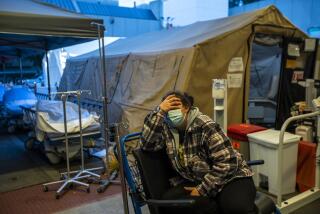With coronavirus patients filling up Inland Empire hospitals, nurses are desperate for relief

- Share via
Arrowhead Regional Medical Center took drastic measures in anticipation of a coronavirus surge following the holiday weekend and statewide reopenings.
In the last few months, administrators set up an outside temporary screening area for emergency patients to open up space in the emergency room within the hospital, and they considered relocating other sections of the hospital to accommodate the growing increase of patients — anything to alleviate the space concerns.
The number of COVID-19 inpatients in the San Bernardino County trauma center nearly tripled from 20 in May to 55 as of Wednesday.
“On the floors, the medics are telling us every bed is full,” said Sharon Brown, associate chief nursing officer.
Two of the hospital’s 16 intensive care beds are unoccupied, and the center has additional beds designated if needed. But nurses said the crowding was worsening.
Inside the COVID unit Wednesday, doctors and nurses moved briskly, performing check-ins, getting medication and drawing labs. At noon, a team of doctors rushed from room to room to check on every patient in the ICU wing.
Throughout San Bernardino County, hospitals have seen a steep increase in coronavirus hospitalizations, rising from about 276 inpatients a month ago to about 579 inpatients Tuesday.
But the trend isn’t unique to San Bernardino — each county in the Inland Empire has reported that its licensed ICU hospital beds are nearly full. And the concerns don’t stop there: Nurses in short-staffed hospitals across the Inland Empire said they bear the brunt of the pressure.
Arrowhead Regional Medical Center has hired more nurses to meet growing demands but still struggles to keep up.
“We’re trying to get [an] agency to help with the staffing, but all the other hospitals are experiencing a surge and they’re using the agency to get more staffers as well, so that presents a challenge,” Brown said.
In Imperial County, 93 suspected and confirmed coronavirus patients were hospitalized Monday, a number that has remained steady for months. But in just five weeks, 500 coronavirus patients from Imperial County had already been transferred to other counties for treatment — San Francisco, Riverside and Santa Clara among them.
More than 20% of the COVID-19 tests administered in Imperial County come back positive, a rate much higher than the threshold of 8% to be removed from a state watchlist. During a news conference June 26, Gov. Gavin Newsom singled out Imperial County as the area hit hardest by the coronavirus in all of California.
And in Riverside County, hospital beds have hovered above 90% capacity each day throughout early July. The county reached a record high of 518 coronavirus hospitalizations Tuesday.
Hospital officials said they anticipate a surge in hospitalizations following the Fourth of July holiday.
“The effects of [the holiday], we will start to feel in one week, two weeks, three weeks. It’s hard to have a crystal ball on that. That bullet has left the gun,” said Bruce Barton, Riverside County’s emergency management director.
Six of the county’s 17 acute-care hospitals have already exceeded their licensed ICU bed capacity, accommodating additional patients in surge bedding. Michael Ditoro, chief operating officer at Desert Regional Medical Center, says the hospital’s surge beds are just as equipped to serve patients as standard ICU beds.
“There’s all this hubbub in the press about running out of ICU beds,” said Erik Andrews, a rapid response nurse at Riverside Community Hospital. “If you’ve ever had surgery before, the entire pre-op and post-op area, you can convert those into ICU beds with almost no effort.”
But the hospital doesn’t have nearly enough nurses, Andrews said.
California laws prescribe minimum nurse-to-patient ratios in the state, but those numbers haven’t been sufficient during “this novel, deadly, highly contagious disease,” Andrews said. For a while, Riverside Community Hospital had increased its ratio during the pandemic, but it dropped back after a few weeks.
Some COVID-19 patients need additional monitoring, Andrews said.
“Their vital signs are not really telling. Sometimes they’ll have incredibly low oxygen saturations, but they’re not distressed in any way,” he said. “Monitoring somebody remotely isn’t that helpful — you actually have to be able to visualize them.”
With thin staffing, Andrews said he hardly gets to take a bathroom or lunch break. He’s gone up to 11 hours wearing one mask.
“The first thing I do when I show up to work is I fill up my water bottle. There’s definitely been times at the end of the day where I look at it, and I’m like, ‘Holy crap, it’s still full.’ I haven’t taken my mask off and taken the time to drink,” he said.
Erin McIntosh, 37, a rapid response nurse at the Riverside hospital, said she often fears for her and her colleagues’ mental well-being.
Nearly every shift, she witnesses nurses overwhelmed from the demands of their job. She often provides a shoulder to cry on as nurses debrief after their shifts.
“We don’t have the adequate staff to take the patient, and I can’t leave their bedside,” McIntosh said. “I’ll be in a room with a patient by myself for eight hours. We don’t have support, and it’s causing nurses to not want to be nurses anymore.”
More to Read
Sign up for Essential California
The most important California stories and recommendations in your inbox every morning.
You may occasionally receive promotional content from the Los Angeles Times.
















